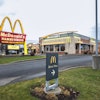
 Rod Daugherty
Rod DaughertyFor businesses in the fast-changing food and beverage industry, finding the perfect inventory levels to avoid surplus and stockouts is a common yet elusive goal. Food wholesalers continue to feel evolving pressure from e-commerce and omnichannel:
- 70 percent1 of consumers will do their grocery shopping online by 2024
- This creates a $100 billion market and additional channels to consider when forecasting demand
- 54 percent of grocery customers say product availability is more important than price
- Customers visit two to three stores on average to do their food shopping, and expect to find customized offerings on the shelf
- 75 percent2 of wholesale suppliers say keeping up with new competitors, customers and channels such as e-commerce is their top challenge in forecasting demand
Food-based businesses struggling to combat complex, unknown demand patterns often turn to stockpiling as a strategy. Many are realizing that more is not always better.
Too Much of a Good Thing?
Stockpiling inventory to meet any foreseeable situation can create additional holding costs and impact profitability. In a recent survey, more than 60 percent of wholesalers report having more than one month of inventory on hand, an increase from 2018.
But even with these record inventory levels, customer service levels are actually dropping. The same survey found that 77 percent of businesses had lost sales, and 27 percent of wholesalers missed sales of more than 4 percent, an 8 percent increase from 2018.
No matter how much inventory you have on hand, some missed sales are inevitable – the key is to develop a data-driven strategy for optimizing inventory levels. That’s an area many food-and-beverage businesses haven’t explored yet. They rely on elementary forecasting models or just trust their gut, instead of using data to make informed purchasing decisions.
Food-based organizations can easily improve customer service levels without the added cost of stockpiling inventory. It just takes some simple math and awareness of what NOT to do.
Here are the five common inventory management mistakes made by food-and-beverage demand planners, and how a more streamlined, data-driven approach can help:
- Not optimizing by product. Nearly four in 10 businesses report difficulties forecasting the lifecycle of individual products. As a result, businesses take a blanket approach and adjust levels across their entire portfolio, rather than considering the factors that impact demand for each SKU. To develop an effective service-level strategy, food wholesalers need a comprehensive baseline forecast that builds in the nuances of individual items.
- Not responding to customer preferences quickly enough. From gluten-free to keto-friendly, what’s popular today can quickly become tomorrow’s castoff. Cultural trends and buying preferences can cause rapid shifts in the products and channels customers want to use. Without a way to monitor these factors in real time, businesses struggle to anticipate deviations from expectations and can wind up inappropriately assigning inventory levels.
- Inability to make seasonal adjustments. Adjusting product levels based on seasonality is an obvious, but often overlooked, forecasting tool. Nearly half (45 percent) of businesses say that predicting seasonal demand is a challenge. To manage these swings successfully, businesses need an inventory optimization system that can make these adjustments and results in a more accurate forecast.
- Not considering external factors. What happens to product demand if a sudden hurricane appears off the East Coast or a restaurant chain’s workers go on strike? Without a platform that considers macro changes in demand, businesses are destined to stumble on inventory optimization.
- Not optimizing order frequency. To offset rising transportation costs, 63 percent of businesses are placing fewer, larger orders. Without taking cost dynamics into account, however, businesses can wind up overpaying for products and ending up with more items than they need. Rather than holding more inventory, businesses need to consider all relevant costs to make more thoughtful decisions about what – and when – to order.
Managing Demand with Data
As demand patterns become more complex, companies across the food industry are realizing that outdated forecasting models are no longer sufficient. Yet businesses have been slow to adopt technology-based approaches, with 50 percent of wholesalers reporting they haven’t used machine learning in their forecasting yet. Establishing a measurement platform can yield significant results for businesses, differentiating them in an industry which still relies largely on manual methods.
The right demand planning technology enables businesses to perform advanced modeling techniques, such as economically optimized replenishment cycles, cost of service analysis and safety stock cycle, so they can forecast with confidence for every product in their portfolios. Using the power of predictive analytics, these technologies empower businesses to produce accurate forecasts based on factors like:
- Customer demographics
- Sale price of items by transaction
- Item promotions
- Competitor information
- Weather
Coupled with the right support, these data-driven demand planning tools can help businesses manage inventory levels more accurately, improve customer service and drive revenue growth. In an industry where customer demand is increasingly elusive, companies that leverage technologies to enhance decision-making have a powerful advantage.
1Nielsen survey (link)
2Blue Ridge and SmartBrief survey
Rod Daugherty is the Vice President of Product Strategy for Blue Ridge, where he oversees product direction. Blue Ridge supply chain solutions are the most accurate way for retailers and distributors to spot changes in customer demand before they happen. For more information, go to www.blueridgeglobal.com.





















